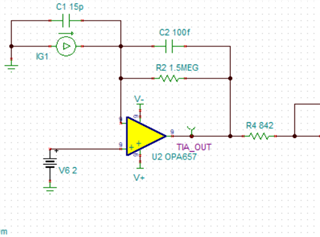Other Parts Discussed in Thread: OPA657,
Hi
I'm testing a tanspidence circuit and find that the temperature at the case of OPA657/OPA656 rises to around 51~52C.
The ambient temperature is around 25C.
The OPAmp is supplied by ±4.5V, the positive ref voltage is 2V, the output is around 1.5V and the ripple is about 37mVpp so I don't thing it gets saturated or oscilating.
And it keeps almost the same hot whenever the photo diode is connnected.
The datasheet shows it should have a very low power consumption.
It would be appreciated if anyone can help/explain it , thanks!



